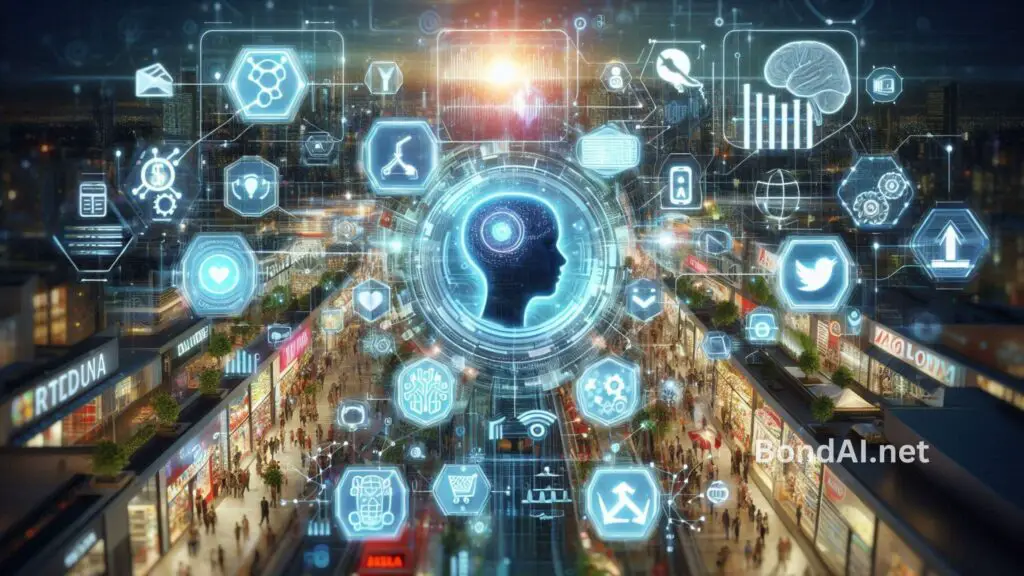The e-commerce world is really being transformed by Artificial Intelligence (AI). From creating personalized shopping experiences to improving behind-the-scenes operations, AI is opening up new opportunities for online retailers. But how exactly is this technology changing the way customers shop and helping businesses grow? Let’s dive in and take a look.
The Growth of AI in E-Commerce
The e-commerce industry has grown rapidly over the past 10 years, making it a great fit for AI technology. What started as basic data analysis has now evolved into advanced algorithms that are shaping the future of online shopping. According to Precedence Research, the global AI market in e-commerce is expected to grow from $5.81 billion in 2022 to $22.6 billion by 2032, with an annual growth rate of 14.6%.

AI in e-commerce includes technologies like data mining, machine learning, and Natural Language Processing (NLP). Together, these innovations help predict customer behavior, automate customer service, and improve logistics and inventory management. With AI, e-commerce platforms can provide more personalized shopping experiences, recommend products based on past behavior, and offer quicker, more efficient customer support.
Predictive Analytics: Streamlining Inventory and Logistics
E-commerce businesses are using AI-powered chatbots and virtual assistants to improve customer service and streamline operations. These tools help by offering round-the-clock support, answering frequently asked questions, and assisting customers with transactions. AI is also making inventory management smarter, using predictive analytics to help businesses predict demand and manage their supply chains better.
On platforms like Amazon, AI plays a big role in improving product listings and customer interactions. By analyzing market trends and customer behavior, AI makes sure products are not just visible but appealing to potential buyers, which helps boost sales. For example, Amazon’s AI-driven recommendation system is responsible for 35% of its sales by suggesting products based on what users are likely to like.
Generative AI: Revolutionizing Content Creation in E-Commerce

Generative AI is shaking things up in e-commerce content creation. This technology helps platforms automatically generate product descriptions and titles that match current trends and what customers are looking for. By keeping the content fresh and relevant, generative AI boosts product listings for both search engines and customer engagement, making sure e-commerce sites stay competitive.
The Future of AI-Powered E-Commerce
The future of e-commerce is being shaped by the ongoing growth of AI, bringing us closer to a world where online shopping is more personalized, intuitive, and interactive. New innovations, like smarter chatbots, predictive tools for managing inventory, and even drone deliveries, are set to transform the shopping experience and make businesses run more efficiently.

Also Read: How does Grammarly Compare to Other AI Editing Tools?
The Role of AI in Personalizing E-Commerce
At the heart of AI’s impact on e-commerce is its ability to provide incredible levels of personalization. In the future, AI won’t just recommend products based on your past purchases — it will be able to predict what you need before you even know it. For example, AI might suggest new running shoes before you even think to search for them, just by analyzing your shopping history and browsing habits.

By constantly adjusting product recommendations, AI makes sure that every customer sees items they’re most likely to love, creating a more enjoyable shopping experience and building stronger customer loyalty.
GenAI for Product Design
Generative AI is changing the way products are designed, making the process faster and more efficient. By analyzing lots of data, AI tools help designers explore different design ideas, create prototypes, and improve both the look and function of products. For example, AI can automatically generate and refine 3D models based on specific guidelines, allowing designers to quickly try new ideas and find solutions they might not have thought of manually. This speeds up the design process and opens up more opportunities for customization, as AI can create variations that meet specific user needs or preferences.
Generative AI is also enhancing the shopping experience with virtual try-ons. Whether it’s clothing, glasses, or makeup, AI can show how products would look on a customer’s image in real-time, creating a personalized and interactive experience. By using deep learning and computer vision, AI can map a customer’s features, like body shape, facial structure, or skin tone, onto virtual products, giving a more accurate preview. This helps customers make better buying decisions and reduces the chance of returns, benefiting both shoppers and retailers by offering a more immersive, data-driven experience.
Generative AI’s Role in Marketing and UX
Generative AI is changing the game in marketing by helping brands create super personalized and dynamic content at scale. Marketers are using AI tools to automate content creation—everything from blog posts and social media updates to customized email campaigns and product descriptions. These AI systems can analyze a lot of consumer data, spotting patterns and preferences to deliver content that speaks to specific target audiences. Plus, generative AI can improve ad targeting by creating tailored ads that match customer behavior, boosting engagement, conversion rates, and overall campaign success.

When it comes to user experience (UX), generative AI is making it easier to design more intuitive, user-friendly interfaces. By analyzing how users interact with a site, AI can predict their behavior and help designers create more personalized experiences. For example, AI can suggest design changes, generate wireframes, or even create entire layouts based on user feedback and past interactions. This makes the design process quicker and more efficient, while ensuring the final product is better suited to what users want, leading to a better overall experience and higher customer satisfaction.

Also Read: How to Integrate AI into Mobile App Development?
Overcoming Challenges with AI
As e-commerce keeps growing, managing an online business comes with its own set of challenges—like keeping transactions secure and handling complex supply chains. AI offers powerful solutions to help with these issues, making security stronger, improving logistics, and giving businesses better insights for managing inventory. With AI, e-commerce platforms can make data-driven decisions based on real-time analytics and offer a secure shopping experience for customers.
Want to take your e-commerce business to the next level with AI? Partner with Gemini Consulting & Services to create smarter, more engaging shopping experiences. Reach out to us today and start your journey toward turning your online store into a personalized, efficient, and unforgettable shopping destination.
Strategically Implementing AI in E-Commerce
To successfully bring AI into your e-commerce business, it’s important to have a solid plan. Here’s how to get started:

- Identify key areas for AI: Figure out where AI can make the biggest difference. This could mean using AI chatbots to automate customer service or applying predictive analytics to better manage inventory.
- Use customer data for personalized experiences: AI works best with data. By collecting and analyzing customer behaviors and preferences, you can tailor shopping experiences to fit individual needs, boosting engagement and increasing sales.
- Optimize product listings for organic growth: Keep your product listings fresh by using AI to update them regularly. This way, you can stay in tune with market trends and consumer search patterns, ensuring your listings remain visible and relevant.
Maximizing the Impact of AI in E-Commerce
E-commerce businesses should focus on blending AI with their current systems to get the most value and drive growth.
- Integrate AI with your current platforms: AI should work alongside your existing e-commerce tools, enhancing them without causing disruptions.
- Train your team: Make sure your team knows how to use AI tools effectively—whether it’s for optimizing product listings or understanding data insights.
- Monitor and improve: Keep an eye on how your AI tools are performing. Regularly evaluate them and adjust based on performance to ensure you’re getting the results you need.

Future Trends

The future of shopping is about to change with AI-powered augmented reality (AR) and virtual reality (VR), creating more immersive and personalized experiences. Soon, shoppers will be able to try on clothes virtually, test products in their own homes, or explore virtual stores—all from the comfort of their living rooms. With AI driving hyperlocal personalization, recommendations, offers, and content will be tailored to fit a person’s location, preferences, and even the weather, making each interaction feel more relevant and appealing. Plus, payment methods are evolving too. AI innovations like voice commerce will let shoppers make purchases using natural language, making the checkout process faster and easier.
Also Read: What are the Best AI Apps for Personal Finance Management?
Embracing the AI Revolution in E-Commerce
Using AI in e-commerce gives businesses a big edge in the digital world. By personalizing the shopping experience, streamlining operations, and solving common problems with smart solutions, AI helps e-commerce platforms not only meet but often exceed customer expectations.

